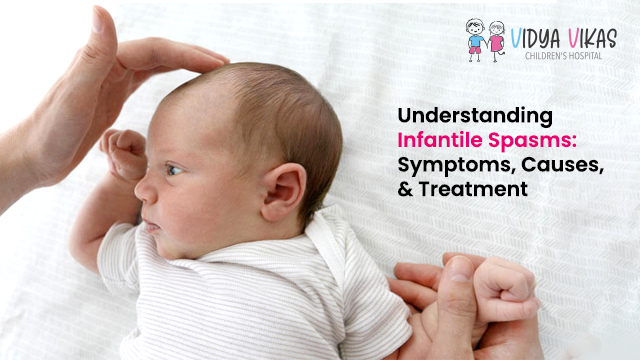


Infantile spasms, also known as West syndrome, is a rare and severe form of epilepsy that can have significant impacts on a child’s development if left untreated. This condition is characterized by clusters of sudden and often violent muscle contractions that can last for several seconds. These spasms usually occur in infants aged between three and twelve months and can manifest as a result of underlying brain abnormalities or genetic mutations. If left untreated, infantile spasms can lead to long-term developmental delays, cognitive impairments, and behavioral problems. Therefore, early diagnosis and treatment are crucial to manage the symptoms and improve the child’s overall quality of life.
Brain Abnormalities: Structural abnormalities in the brain, such as cortical dysplasia, tuberous sclerosis, or brain malformations, can lead to infantile spasms.
Genetic Factors: In some cases, genetic mutations or abnormalities may contribute to the development of infantile spasms. Certain genetic syndromes, such as Down syndrome or Angelman syndrome, are associated with a higher risk of infantile spasms.
Metabolic Disorders: Certain metabolic disorders, such as phenylketonuria (PKU), can cause infantile spasms.
Hypoxic-Ischemic Injury: Brain injury due to lack of oxygen (hypoxia) or inadequate blood flow (ischemia) during birth or in the neonatal period may lead to infantile spasms.
Infections: Some infections, such as meningitis or encephalitis, can trigger infantile spasms.
Unknown Causes: In many cases, the cause of infantile spasms remains unknown, which can be frustrating for families and healthcare providers.
Infantile spasms typically involve a specific type of seizure activity characterized by three main components:
Flexion: The infant may suddenly flex their arms, legs, or trunk. This movement often appears as a sudden and forceful bending or arching of the body.
Extension: Following the flexion, there may be a brief period of extension, where the body straightens or stiffens out.
Jerking Movements: Some infants may also exhibit jerking movements, such as repetitive movements of the arms, legs, or head.
These spasms usually occur in clusters, meaning that several spasms may happen in a short period, often occurring close together. The spasms typically last for just a few seconds, but they can occur multiple times throughout the day, including during sleep.
It’s essential to note that infantile spasms can be subtle and easily overlooked, especially if they occur infrequently or if the infant is experiencing other developmental delays or health issues. If a parent or caregiver suspects that their infant is experiencing seizures or unusual movements, they should seek medical attention promptly for evaluation and diagnosis. Early detection and treatment are crucial for managing infantile spasms and minimizing potential developmental complications.
Early Diagnosis is Key
The timely identification and diagnosis of infantile spasms are of utmost importance for the successful management of the condition. As parents and caregivers, it is crucial to remain vigilant and observant of your infant’s unusual movements or behaviors. If you notice anything unusual, seeking prompt medical evaluation is highly recommended to ensure timely intervention and treatment. Remember, early detection and management are crucial to achieving better outcomes for your child’s health and well-being.
Causes of Infantile Spasms
While the exact cause of infantile spasms is often unknown, they can be associated with various underlying conditions, including brain abnormalities, genetic disorders, or metabolic imbalances. Identifying the underlying cause can guide treatment and management strategies.
Treatment Options
Early intervention is essential in managing infantile spasms. Treatment typically involves a combination of antiepileptic medications, such as adrenocorticotropic hormone (ACTH) or oral corticosteroids, along with supportive therapies. In some cases, a ketogenic diet or surgery may be considered.It is advisable to contact an experienced pediatrician
Infantile spasms is a complex neurological disorder that can be difficult to manage. The condition is characterized by sudden, involuntary muscle contractions that can occur in clusters, and can be accompanied by a range of other symptoms, including developmental delays, cognitive impairment, and seizures. Early detection and timely intervention are essential in treating infantile spasms, as this can significantly improve the prognosis and long-term outcomes for affected children. It is, therefore, important to raise awareness and understanding of this condition among healthcare professionals, parents, and caregivers to facilitate early diagnosis and intervention.
1: Can infantile spasms cause long-term complications?
A: Yes, untreated infantile spasms can lead to developmental delays, learning disabilities, or even permanent brain damage.
2: Are infantile spasms curable?
A: While there is no definitive cure for infantile spasms, early diagnosis and appropriate treatment can significantly improve outcomes and reduce the frequency of seizures.
3: When should I seek medical help if I suspect my child has infantile spasms?
A: Any concerns about abnormal movements or behaviors in your child should be promptly discussed with a pediatrician or pediatric neurologist for further evaluation and diagnosis.